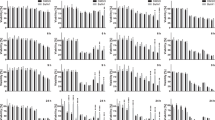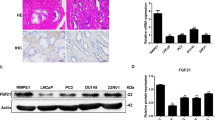Abstract
Bladder cancer is a major public health problem worldwide, with relatively high morbidity. However, there are few studies on drug development for bladder cancer. Troglitazone (TZ) is a synthetic ligand of peroxisome proliferator-activated receptor-γ, and it can induce apoptosis and autophagy in a variety of cancer cells. Several studies have indicated that TZ affects both cell growth and differentiation progress and has an inhibitory effect on urinary cancer cells. However, this drug’s effect on bladder cancer cells remains largely unknown. Here, we report that TZ induced autophagy and enhanced apoptosis in T24 cells. Autophagic blockage resulted in the attenuation of TZ-dependent apoptosis. Necrostatin-1, an inhibitor of necroptosis, was found to reduce light chain 3 (LC3)-II accumulation and partially rescue the loss of cell viability induced by TZ. It was demonstrated that TZ activated autophagy concurrent with the activation of the adenosine monophosphate-dependent protein kinase (AMPK) signaling pathway. AMPK inhibition led to a reduction in LC3-II levels, which were responsive to TZ treatment. Overall, TZ induced multiple types of programmed cell death in bladder cancer cells, and while the autophagy induced by the agonist contributed to the apoptotic process, crosstalk or switching between the different types of cell death likely occurred.
This is a preview of subscription content, access via your institution
Access options
Subscribe to this journal
Receive 12 print issues and online access
$259.00 per year
only $21.58 per issue
Buy this article
- Purchase on Springer Link
- Instant access to full article PDF
Prices may be subject to local taxes which are calculated during checkout





Similar content being viewed by others
References
Zhang S-W, Lei LZ, Li LG, Zou XN, Zhao P, Chen WQ . A report of cancer incidence and mortality from 34 cancer registries in China, 2006. China Cancer 2010; 19: 356–365.
Jemal A, Bray F, Center MM, Ferlay J, Ward E, Forman D . Global cancer statistics. CA Cancer J Clin 2011; 61: 69–90.
Munro NWP . Bladder cancer. Surgery (Oxford) 2006; 24: 181–184.
Pectasides D, Pectasides M, Nikolaou M . Adjuvant and neoadjuvant chemotherapy in muscle invasive bladder cancer: literature review. Eur Urol 2005; 48: 60–68.
von der Maase H, Hansen SW, Roberts JT, Dogliotti L, Oliver T, Moore MJ et al. Gemcitabine and cisplatin versus methotrexate, vinblastine, doxorubicin, and cisplatin in advanced or metastatic bladder cancer: results of a large, randomized, multinational, multicenter, phase III study. J Clin Oncol 2000; 18: 3068–3077.
Degenhardt K, Mathew R, Beaudoin B, Bray K, Anderson D, Chen G et al. Autophagy promotes tumor cell survival and restricts necrosis, inflammation, and tumorigenesis. Cancer Cell 2006; 10: 51–64.
Amaravadi RK, Yu D, Lum JJ, Bui T, Christophorou MA, Evan GI et al. Autophagy inhibition enhances therapy-induced apoptosis in a Myc-induced model of lymphoma. J Clin Invest 2007; 117: 326–336.
Klionsky DJ, Emr SD . Autophagy as a regulated pathway of cellular degradation. Science 2000; 290: 1717–1721.
Gozuacik D, Kimchi A . Autophagy as a cell death and tumor suppressor mechanism. Oncogene 2004; 23: 2891–2906.
Galluzzi L, Vitale I, Abrams JM, Alnemri ES, Baehrecke EH, Blagosklonny MV et al. Molecular definitions of cell death subroutines: recommendations of the Nomenclature Committee on Cell Death 2012. Cell Death Differ 2012; 19: 107–120.
Daynes RA, Jones DC . Emerging roles of PPARs in inflammation and immunity. Nat Rev Immunol 2002; 2: 748–759.
Issemann I, Green S . Activation of a member of the steroid hormone receptor superfamily by peroxisome proliferators. Nature 1990; 347: 645–650.
Chaffer CL, Thomas DM, Thompson EW, Williams ED . PPARgamma-independent induction of growth arrest and apoptosis in prostate and bladder carcinoma. BMC Cancer 2006; 6: 53.
Guan Y, Zhang Y, Davis L, Breyer MD . Expression of peroxisome proliferator-activated receptors in urinary tract of rabbits and humans. Am J Physiol 1997; 273 (6 Pt 2): 1013–1022.
Nakashiro KI, Hayashi Y, Kita A, Tamatani T, Chlenski A, Usuda N et al. Role of peroxisome proliferator-activated receptor gamma and its ligands in non-neoplastic and neoplastic human urothelial cells. Am J Pathol 2001; 159: 591–597.
Gallagher LE, Chan EY . Early signalling events of autophagy. Essays Biochem 2013; 55: 1–15.
Fediuc S, Pimenta AS, Gaidhu MP, Ceddia RB . Activation of AMP-activated protein kinase, inhibition of pyruvate dehydrogenase activity, and redistribution of substrate partitioning mediate the acute insulin-sensitizing effects of troglitazone in skeletal muscle cells. J Cell Physiol 2008; 215: 392–400.
Klionsky DJ, Abdalla FC, Abeliovich H, Abraham RT, Acevedo-Arozena A, Adeli K et al. Guidelines for the use and interpretation of assays for monitoring autophagy. Autophagy 2012; 8: 445–544.
Cui J, Bai XY, Shi S, Cui S, Hong Q, Cai G et al. Age-related changes in the function of autophagy in rat kidneys. Age 2012; 34: 329–339.
Bartlett BJ, Isakson P, Lewerenz J, Sanchez H, Kotzebue RW, Cumming RC et al. p62, Ref(2)P and ubiquitinated proteins are conserved markers of neuronal aging, aggregate formation and progressive autophagic defects. Autophagy 2011; 7: 572–583.
Klionsky DJ, Meijer AJ, Codogno P . Autophagy and p70S6 kinase. Autophagy 2005; 1: 59–60, discussion 60-1.
Colin-Cassin C, Yao X, Cerella C, Chbicheb S, Kuntz S, Mazerbourg S et al. PPARgamma-inactive Delta2-troglitazone independently triggers ER stress and apoptosis in breast cancer cells. Mol Carcinog 2013 doi:10.1002/mc.22109 (e-pub ahead of print).
Bolden A, Bernard L, Jones D, Akinyeke T, Stewart LV . The PPAR gamma agonist Troglitazone regulates Erk 1/2 phosphorylation via a PPARgamma-independent, MEK-dependent pathway in human prostate cancer cells. PPAR Res 2012; 2012: 929052.
Plissonnier ML, Fauconnet S, Bittard H, Lascombe I . Insights on distinct pathways of thiazolidinediones (PPARgamma ligand)-promoted apoptosis in TRAIL-sensitive or -resistant malignant urothelial cells. Int J Cancer 2010; 127: 1769–1784.
Oliver FJ, de la Rubia G, Rolli V, Ruiz-Ruiz MC, de Murcia G, Murcia JM . Importance of poly(ADP-ribose) polymerase and its cleavage in apoptosis. Lesson from an uncleavable mutant. J Biol Chem 1998; 273: 33533–33539.
Seglen PO, Gordon PB . 3-methyladenine: specific inhibitor of autophagic/lysosomal protein degradation in isolated rat hepatocytes. Proc Natl Acad Sci USA 1982; 79: 1889–1892.
Ekert PG, Silke J, Vaux DL . Caspase inhibitors. Cell Death Differ 1999; 6: 1081–1086.
Degterev A, Hitomi J, Germscheid M, Ch’en IL, Korkina O, Teng X et al. Identification of RIP1 kinase as a specific cellular target of necrostatins. Nat Chem Biol 2008; 4: 313–321.
Kim J, Guan KL . Regulation of the autophagy initiating kinase ULK1 by nutrients: roles of mTORC1 and AMPK. Cell Cycle 2011; 10: 1337–1338.
Lu Z, Luo RZ, Lu Y, Zhang X, Yu Q, Khare S et al. The tumor suppressor gene ARHI regulates autophagy and tumor dormancy in human ovarian cancer cells. J Clin Invest 2008; 118: 3917–3929.
Yang S, Wang X, Contino G, Liesa M, Sahin E, Ying H et al. Pancreatic cancers require autophagy for tumor growth. Genes Develop 2011; 25: 717–729.
Shao Y, Gao Z, Marks PA, Jiang X . Apoptotic and autophagic cell death induced by histone deacetylase inhibitors. Proc Natl Acad Sci USA 2004; 101: 18030–18035.
Turcotte S, Chan DA, Sutphin PD, Hay MP, Denny WA, Giaccia AJ . A molecule targeting VHL-deficient renal cell carcinoma that induces autophagy. Cancer Cell 2008; 14: 90–102.
Eisenberg-Lerner A, Bialik S, Simon HU, Kimchi A . Life and death partners: apoptosis, autophagy and the cross-talk between them. Cell Death Differ 2009; 16: 966–975.
Kim J, Kundu M, Viollet B, Guan KL . AMPK and mTOR regulate autophagy through direct phosphorylation of Ulk1. Nat Cell Biol 2011; 13: 132–141.
Yan J, Yang H, Wang G, Sun L, Zhou Y, Guo Y et al. Autophagy augmented by troglitazone is independent of EGFR transactivation and correlated with AMP-activated protein kinase signaling. Autophagy 2010; 6: 67–73.
Samari HR, Moller MT, Holden L, Asmyhr T, Seglen PO . Stimulation of hepatocytic AMP-activated protein kinase by okadaic acid and other autophagy-suppressive toxins. Biochem J 2005; 386 (Pt 2): 237–244.
Meley D, Bauvy C, Houben-Weerts JH, Dubbelhuis PF, Helmond MT, Codogno P et al. AMP-activated protein kinase and the regulation of autophagic proteolysis. J Biol Chem 2006; 281: 34870–34879.
Shang L, Chen S, Du F, Li S, Zhao L, Wang X . Nutrient starvation elicits an acute autophagic response mediated by Ulk1 dephosphorylation and its subsequent dissociation from AMPK. Proc Natl Acad Sci USA 2011; 108: 4788–4793.
Acknowledgements
We thank Dr Tamotsu Yoshimori from Osaka University for the GFP-LC3 plasmid. This work was supported by grants from the National Natural Science Foundation of China (31171329 and 81272829).
Author information
Authors and Affiliations
Corresponding authors
Ethics declarations
Competing interests
The authors declare no conflict of interest.
Rights and permissions
About this article
Cite this article
Yan, S., Yang, X., Chen, T. et al. The PPARγ agonist Troglitazone induces autophagy, apoptosis and necroptosis in bladder cancer cells. Cancer Gene Ther 21, 188–193 (2014). https://doi.org/10.1038/cgt.2014.16
Received:
Revised:
Accepted:
Published:
Issue Date:
DOI: https://doi.org/10.1038/cgt.2014.16
This article is cited by
-
A novel BH3 mimetic Bcl-2 inhibitor promotes autophagic cell death and reduces in vivo Glioblastoma tumor growth
Cell Death Discovery (2022)
-
4,5-diazafenylfluorene-rhodanine conjugates promote anoikis in A375 cells via inhibiting PPAR-γ expression
Medicinal Chemistry Research (2022)
-
Targeting androgen receptor (AR) with antiandrogen Enzalutamide increases prostate cancer cell invasion yet decreases bladder cancer cell invasion via differentially altering the AR/circRNA-ARC1/miR-125b-2-3p or miR-4736/PPARγ/MMP-9 signals
Cell Death & Differentiation (2021)
-
PPARγ activation serves as therapeutic strategy against bladder cancer via inhibiting PI3K-Akt signaling pathway
BMC Cancer (2019)
-
New insight for metformin against bladder cancer
Genes and Environment (2017)



